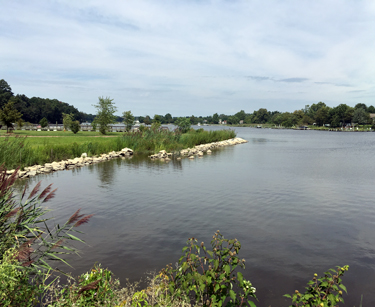 The Corsica River, located in Queen Anne's County and transecting the Town of Centreville, is meeting its Total Maximum Daily Load (TMDL) allocations, set by Maryland Department of the Environment, for nitrogen and phosphorus. This is a big news, and has taken years of planning and major restoration efforts to accomplish the goal. The determined maximum amounts allowable (217,106 pounds of nitrogen and 13,986 pounds of phosphorus, per year) were calculated by the number of non-point source practices put on the ground, such as stream and wetland restoration, stormwater retrofits, and agricultures best management practices like cover crops. Point sources were also added into the equation-mainly the wastewater treatment plant in Centreville. Based on the estimated reductions per practice, the total pounds entering the Corsica River should be meeting the TMDL goals. Queen Anne's County and the Town of Centreville are celebrating the Corsica River meeting its Total Maximum Daily Load (TMDL) allocations! This is a big news! These TMDL allocations for nitrogen and phosphorus were established in 2000 by Maryland Department of the Environment and approved by the US Environmental Protection Agency. The TMDL sets the maximum amount of nitrogen and phosphorus input to the river to meet water quality standards set for the Corsica. Meeting this goal has taken years of planning and major restoration. Practices implemented to achieve this goal include stream and wetland restoration, stormwater retrofits, and agricultures best management practices like cover crops as well as point sources upgrades to wastewater treatment plants. Through implementation of these practices, nitrogen and phosphorous inputs have been calculated to achieve the maximum allowable loads to the river of 217,106 pounds of nitrogen and 13,986 pounds of phosphorus per year.
The Corsica River, located in Queen Anne's County and transecting the Town of Centreville, is meeting its Total Maximum Daily Load (TMDL) allocations, set by Maryland Department of the Environment, for nitrogen and phosphorus. This is a big news, and has taken years of planning and major restoration efforts to accomplish the goal. The determined maximum amounts allowable (217,106 pounds of nitrogen and 13,986 pounds of phosphorus, per year) were calculated by the number of non-point source practices put on the ground, such as stream and wetland restoration, stormwater retrofits, and agricultures best management practices like cover crops. Point sources were also added into the equation-mainly the wastewater treatment plant in Centreville. Based on the estimated reductions per practice, the total pounds entering the Corsica River should be meeting the TMDL goals. Queen Anne's County and the Town of Centreville are celebrating the Corsica River meeting its Total Maximum Daily Load (TMDL) allocations! This is a big news! These TMDL allocations for nitrogen and phosphorus were established in 2000 by Maryland Department of the Environment and approved by the US Environmental Protection Agency. The TMDL sets the maximum amount of nitrogen and phosphorus input to the river to meet water quality standards set for the Corsica. Meeting this goal has taken years of planning and major restoration. Practices implemented to achieve this goal include stream and wetland restoration, stormwater retrofits, and agricultures best management practices like cover crops as well as point sources upgrades to wastewater treatment plants. Through implementation of these practices, nitrogen and phosphorous inputs have been calculated to achieve the maximum allowable loads to the river of 217,106 pounds of nitrogen and 13,986 pounds of phosphorus per year.
Water quality monitoring is also starting to capture some improving conditions in the Corsica River. Small reductions in nitrogen in two of the non-tidal tributaries and a slight improvement in oxygen conditions in portions of the tidal river are documented. The monitoring data shows that the river is slowly responding to all the restoration practices put in place over the last 10+ years. So while we are on the right path, the river will need more time to fully recover. In addition, nutrient-saturated ground water resulting from past actions could continue to influence the system for the next 20 to even 30 years.
We must, however, continue to be diligent to maintain all of the practices and work put in place for the river to fully respond and continue to recover. No one can go home and rest. Cover crops, stormwater practices, land owner cooperation and education must continue into the future for our rivers and streams to meet water quality goals. Support from and for groups like the Corsica River Conservancy, a local non-profit, help to remind everyone to continue the good work of the community.
The Corsica River Target Watershed Project evolved from the completion of the Corsica River Watershed Restoration Action Strategy (WRAS). The WRAS is a watershed Plan developed through funding and technical support from Maryland's Department of Natural Resources and later supported by the Maryland department of the Environment. This Watershed Plan was the first in Maryland to be approved by EPA and was highlighted nationally primarily because of the strong support and partnership of the state, local, municipal, and private non-profit organizations working together to develop and implement the Plan. Town of Centreville, Queen Anne's County, and the Corsica River Conservancy's continue their interest and partnership through participation in the Corsica River Implementers Committee which meets monthly and pushes the agenda of protecting and restoring the river for current and future generations.